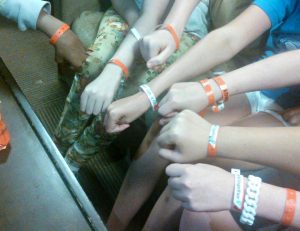The Real Red Band Society

In 2014, my son Cullen received a heart and double-lung transplant after a long battle with pulmonary hypertension (PH). Washington state was home, but for the first four months of recovery, we lived in California, close to the hospital where he received his transplant.
Except for an occasional visit, his dad and brother remained in Washington. We would have felt lonely if not for friends who also were tethered to the hospital for equally serious reasons.
Initially, the group consisted of what I fondly referred to as the “Three Musketeers.” The trio shared years of battling PH together and received transplants within a short time of each other.
It did not take long for this compassionate posse to make friends with several other teens who were also regulars at the hospital. They battled different enemies — PH, transplant, cancer, lupus, and heart disease — but shared the battlefield with compassion, understanding, trust, and loyalty.
A new television show was scheduled to air in September of that year, called “Red Band Society.” The trailer showed a group of teenagers helping each other deal with illness while living in a hospital’s pediatric ward. Cullen and his friends could not wait to watch a show that could have been based on their own lives.
They gathered for the first episode wearing red “We BAND together” bracelets pushed up against real patient hospital wristbands. The show was not quite as expected, and we laughed through a lot of it. The hospital suites looked more like spacious dorm rooms and there was barely any medical equipment at the bedsides. Also missing was the consistent presence of parents and medical staff. It appeared these young patients were free to roam or even leave the hospital without notice whenever their hearts desired.
If you have ever watched “Mystery Science Theater 3000,” then you know how we reacted to “Red Band Society.” The characters were portrayed as needing transplants and battling diseases such as cancer, cystic fibrosis, and anorexia. The mischief, romance, and animosity shared among them seemed unrealistic for young people facing such huge health challenges.
As I shared in a previous column, Cullen and his friends enjoyed laughing and playing pranks on each other and on hospital staff, but never to the point of risking their fragile health. They also spent a lot of time sitting quietly together with cellphones, laptops, or books. The foundation of their friendships rested on respect, kindness, and maturity beyond their years.
My personal review of the show is not completely thumbs down, because there were relatable scenes that touched my heart. In the first episode, I cried when cancer patient Leo gave each of his friends a hospital band from an admission, treatment, or surgery that he survived.
Keeping the red hospital wristbands was something Cullen had been doing since he was 8. He wore them until they would break, and sometimes, he would go months with multiple bands on each wrist. They were a reminder that it is possible to get through tough times. Superstitiously, he also hoped that keeping them on would delay his need to return to the hospital and receive new ones.
His most precious band was the one he received for transplant. I never thought he would part with it, but he gave it to a PH friend who was losing faith that she would receive her gift of life in time. Only days after giving it to her, she received a successful heart and double-lung transplant.
Endearing to the show was the character Charlie, a patient in a coma who narrated parts of every episode. His words were always compassionate, intuitive, and wise, which is truer to how sick kids think.
Leo acknowledged Charlie as part of the red band society by placing one of his treasured bands on Charlie’s limp wrist. Internally, Charlie said, “Luck isn’t about getting what you want, it’s surviving what you don’t want.” I think those words sum up well the symbolism of the wristbands.
Charlie also summarized well one of the most valuable things a friend, caregiver, and even members of medical staff can provide to a patient. “Sometimes we don’t need to walk in another person’s shoes to know how they feel, sometimes the best thing we can do is sit beside them.”
The show was entertaining by exaggerating life in a pediatric hospital. Best of all, for one season, it gathered a real “Red Band Society” together. Watching the show again brought back precious memories of Cullen and his remarkable friends, some who are still with us, and sadly, some who are not. I wish I could go back in time and watch it with them all again.
***
Note: Pulmonary Hypertension News is strictly a news and information website about the disease. It does not provide medical advice, diagnosis, or treatment. This content is not intended to be a substitute for professional medical advice, diagnosis, or treatment. Always seek the advice of your physician or other qualified health provider with any questions you may have regarding a medical condition. Never disregard professional medical advice or delay in seeking it because of something you have read on this website. The opinions expressed in this column are not those of Pulmonary Hypertension News or its parent company, Bionews Services, and are intended to spark discussion about issues pertaining to pulmonary hypertension.









Jen Cueva
Wow! I watched this show, too. It was far from what I expected because of the reality of hospital life. I love hearing these stories and how you choose to share them in your column.
Excellent job, Coleen!
Colleen Steele
Thank you, Jen! Sometimes it's surprising what memories become precious years down the road.